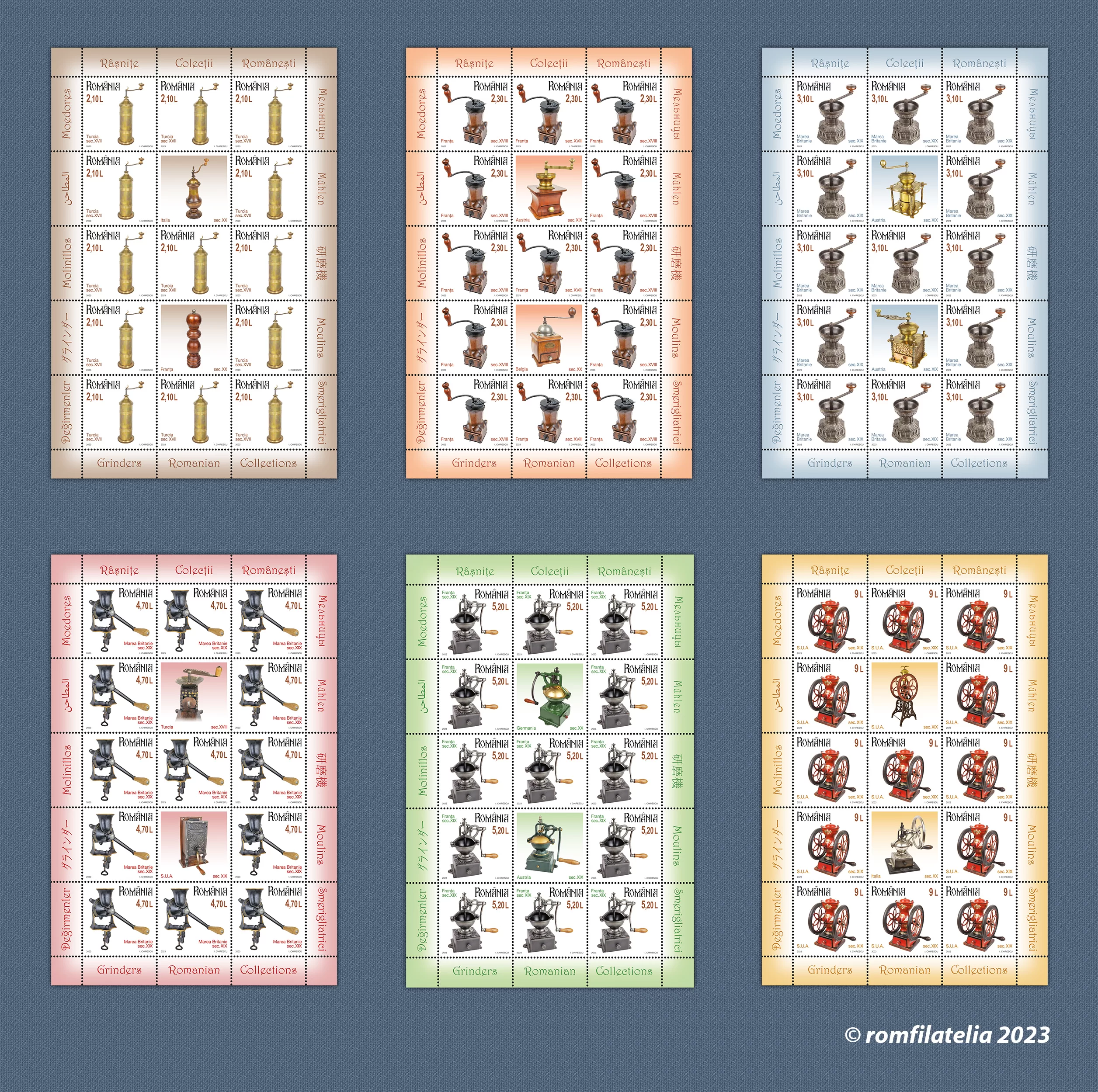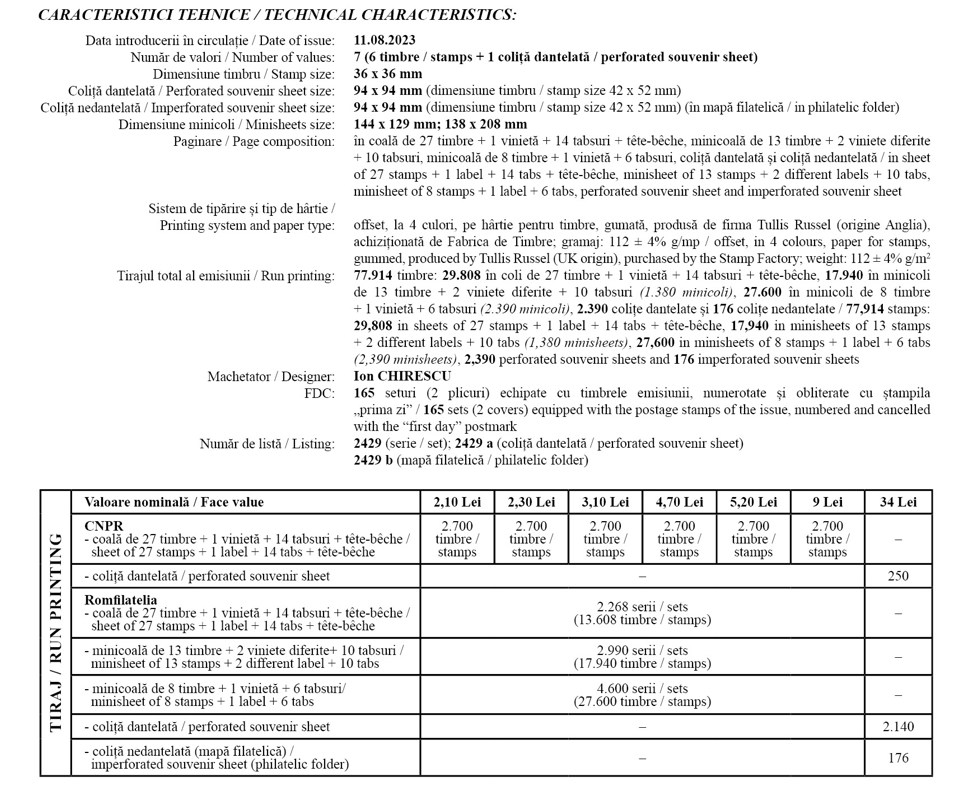 In the “Romanian Collections” theme, Romfilatelia introduces into circulation the Grinders issue, on Friday, August 11th, this year, with a set of six postage stamps, a perforated souvenir sheet, a First Day Cover and a special philatelic folder, illustrating “collection grinders” with special shapes and embellishments used for grinding coffee.
In the “Romanian Collections” theme, Romfilatelia introduces into circulation the Grinders issue, on Friday, August 11th, this year, with a set of six postage stamps, a perforated souvenir sheet, a First Day Cover and a special philatelic folder, illustrating “collection grinders” with special shapes and embellishments used for grinding coffee.
Coffee’s origins lie in a region of Ethiopia called Koffe. It reached the Arab world via Egypt and Yemen and began to be cultivated for commercial purposes. It became known in Egypt, Persia and Turkey.
In Europe, coffee arrives for the first time in Italy, in Venice. Towards the end of the 16th century, coffee houses appear almost everywhere in Europe. It wasn’t long before the American continent became a major coffee producer.
Naturally, the need arises to turn coffee beans into a powder to make it possible to obtain more quickly the liqueur that has conquered the entire world: coffee, the most popular drink.
This is how the coffee grinder came into being, becoming a permanent fixture in coffee shops and then an irreplaceable aid in families who want coffee with a special flavour obtained by grinding the brown beans.
The coffee or spice grinder is depicted on the stamp with the face value of Lei 2.10. Handmade Turkish coffee bean or spice grinder, 17th century. This grinder is a classic model and is a symbol of the Turkish tradition of coffee making. The Turks, being big coffee drinkers, started grinding coffee beans using grinders. Later, they started making cylindrical grinders with a sleek and compact design and two compartments. Coffee beans or spices are added to the upper compartment and ground in the lower one. The two compartments are separated by the grinding mechanism which is operated by a circular movement of the crank handle.
The “Louis XIV” Coffee Grinder is illustrated on the stamp with the face value of Lei 2.30. Handcrafted “Louis XIV” wooden grinders were widely used in the 18th century and represent some of the most prized and sought-after designs by collectors. They were most often made of walnut and iron, with eight faces, never six or ten. This shows, beyond the variety of models, a fidelity to French archetypes and traditions. However, the care given to the decoration of these “Louis XIV” grinder models has diminished as these objects have become less unusual. Thus, mass production shrank and led to a simplification of forms.
The Kenrick decorative grinder, reproduced on the stamp with the face value of Lei 3.10, is inscribed on the bottom “AK & Sons”, with the design “York Cathedral Fountain”, dated circa 1850. Archibald Kenrick & Sons was founded in 1791 at Spons Lane, West Bromwich, UK as a foundry. Kenrick manufactured cast iron ware, mainly for culinary use.
Coffee grinders from this period were handcrafted and still reflect the influences of Turkish or other oriental cultures. European industrialization started 15 to 20 years later than in the US and only found its way into coffee grinder production in the factories of a few, such as Peugeot and Kenrick.
The Kitchen coffee grinder is depicted on the stamp with the face value of Lei 4.70. This grinder dates back to the 19th century and was produced by the renowned company SPONG & CO. LTD from England. The Spong company started making coffee grinders in the 1850s and has continued to do so for over 100 years. Only top-quality materials were used in the manufacture of this model and every detail was given special attention. The grinder can be used either wall-mounted or table-mounted, depending on the user’s preference. What differentiates this grinder from other models is the grinding mechanism. The fact that it is composed of very sharp blades ensures an even and precise grinding of the coffee beans, and by adjusting them you can achieve different degrees of bean grind, from coarse, suitable for brewing coffee with a French press, to very fine, suitable for espresso coffee. The presence of this grinder gave a special look to any kitchen.
The Peugeot coffee grinder – Model A, illustrated on the stamp with the face value of Lei 5.20, is a model designed in the early 1860s. In 1810, the Peugeot brothers (Jean-Pierre, Jean-Pierre I and Jean Frédéric) converted their grain mill into a steel-making factory. The Peugeot brothers’ performance in steelmaking led them to start producing coffee grinders in 1840. Over the years, the manufacture of these grinders has been steadily increasing; their production ceased with the advent of electric coffee grinders. The lion emblem on PEUGEOT FRÈRES grinders appeared on the market in 1847 and officially became a registered trademark in 1858. The marks evolved in shape and material: square, oval or triangular, in cast iron or nickel-plated cast iron. This logo represented not only the region of France where they were produced, but also the quality and durability of these products.
The Early Enterprise No. 2 (Baby 2) coffee grinder, depicted on the stamp with the face value of Lei 9, equipped with 7-1/2 wheels, made after 1877. The wheels are engraved “Enterprise Mfg. Co., Philadelphia PA, Pat. Dec.9, 1873,” and the iron base is similarly marked, except that the patent date is Oct. 21, 1873. Enterprise Manufacturing Co. of Philadelphia, Pennsylvania, was founded in 1866. An inventive genius, John Gulick Baker, joined the company three years later. His 1870 and 1873 patents formed the foundation of Enterprise’s prolific coffee grinder business for the next half century.
The years following the Civil War marked the beginning of the rapid growth of the U.S. coffee industry. Per capita coffee consumption increased dramatically and the population was growing rapidly.
Patents covering a variety of roasting, grinding and brewing devices helped catalyse the meteoric growth of the coffee business. So did the age of industrialisation. Factories and roasters multiplied in number and size. Their output could be promoted and sold quickly, then transported anywhere in the country by rail. With this as a backdrop, several major manufacturers of coffee grinders and other household items were incorporated and became prominent.
The Sablier coffee grinder (Hourglass) is represented on the perforated souvenir sheet of the issue having the stamp with the face value of Lei 34. The grinder with a heart-shaped vice grip appeared at the beginning of the 18th century, during the reign of Louis XIV, and is made of wrought iron. The heart-shaped foot (the vise) is reminiscent of the “Fleur de lys” – lily flower, as a symbol of royalty and luxury. The latch on the lid slides to lock the lid in the closed position.
The arrival of coffee in France dates back to around 1670, in the context of numerous exchanges with the East. Very quickly appreciated by the court of Louis XIV, its diffusion in high society was immediate and its consumption became a marker of elegance and modernity. Indeed, the rarity and high cost of coffee beans made the grinder an object of luxury and social distinction, guaranteeing its owner refinement.
Craftsmen added decorative elements that made their grills more attractive and appealing to their patrons. These designs frequently alluded to the drink’s oriental or Turkish origins.
The grinders used in the 17th century were often small and their role was to grind spices. As the new coffee drink gained popularity, adaptations were made to the models to grind the beans more efficiently; these included enlarging the hoppers, lengthening the handle and reconfiguring the grinding surfaces.
The grinders belong to the collection of the Museum of the Romanian Records.



